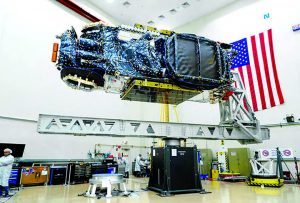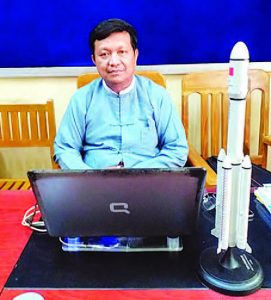The Myanmar’s very own Earth Observation Satellite, Myanmar Sat 2 or Intelsat 39, which is now in Ariane Space Launch Base in French Guiana in South America, will be launched at 2 am on 7 August Myanmar standard time, according to Information Technology and Cyber Security Department.
The initial launching date of Myanmar Sat 2 was on 24 July this year, but it was delayed due to the failure of an Italian-manufactured satellite that crashed only minutes after it was launched from the Ariane Space Station on 10 July.
Information Technology and Cyber Security Department and Intelsat company signed an agreement in connection with the Myanmar Sat 2 on 1 June 2018. Under the agreement, Maxar Technologies manufactured Myanmar Sat 2 at a cost of US 155.7 million as its 52nd satellite.
Thanks to the Myanmar Sat 2, Myanmar’s telecommunication operators will be able to offer high-speed rates while videos across Africa, Asia, Europe, the Middle East and Indian Ocean region can be downloaded quickly.
In this regard, we interview Chief Engineer U Win Aung of Information Technology and Cyber Security Department, about the launching program in detail.
Q: Please explain the launching program of Earth Observation Satellite, Myanmar Sat 2 or Intelsat 39.
A: The satellite was manufactured by California-based Palo Alto, formally known as Space System Loral (SSL). It is now called Maxar Technologies. We placed an order of the satellite at the Maxar Technologies. After a thorough test, we sent it to the launch site.
We also made an order of the launch vehicle. Some poduce the launch vehicle at the other place, and send it to the launch site. But in some cases the company that runs the launch site is the manufacturer. So it transports the launch vehicle to its own launch site. Myanmar Sat 2 is a joint program with Intelsat Satellite Operator. We can name the Myanmar own part “Myanmar Sat 2.” After a detailed test, we sent the satellite to the launch site. Arianespace, a French-owned company, builds Ariane 5 booster rockets, and blasts them off from its Ariane Space Launch Base in French Guiana, a French territory facing the Atlantic Ocean at the northern tip of South American Continent.

Q: As Myanmar Sat 2 will be launched soon, what are your current operations in connection with aerospace industry?
A: We are currently leasing satellite channels from the US, China, Thailand, Viet Nam and Indonesia at an annual cost exceeding $10 million. So, the cost is high.
Q: We have heard that the launching date of Myanmar Sat 2 was earmarked on 24 July. But later it was postponed. What is the cause?
A: Originally, the take off date of Intelsat 39 which included Myanmar Sat 2 was earmarked on 24 July. It was put off later because of the loss of a Vega rocket which was to launch a United Arab Emirates’ low-orbiting earth observation satellite on 10 July. The rocket failed just minutes after the liftoff. So, we have to make sure everything is normal and functional. We targeted the liftoff date on 2 August. But it was delayed as the test procedure of the EDRSC-C, a co-passenger satellite, that will also be included in Intelsat 39 had not finished then.
Q: So, what is the new liftoff date?
A: We hope that the launch vehicle can be taken-off at 4:30 pm local standard time on 6 August (2 am Myanmar standard time on 7 August) as the test procedure is complete.
Q: What kind of services will Myanmar Sat 2 provide?
A: Myanmar Sat 2 will allow improved and faster connectivity across the country, including in remote areas, where there are no fibre links or microwave links yet. It would also allow communications to be established quickly in case of a natural disaster, so photos, videos, and information can be shared, thereby, contributing significantly to the success of rescue works.

Q: What are the possible benefits for the country?
A: As the satellite will be applying the latest technology, connectivity will be 8 to 10 times faster than Myanmar Sat 1. It will offer high-speed rates for mobile internet and other communication networks.
Q: Anything more?
A: The new satellite will start using a C-band and Kuband of the satellite spectrum, which can provide a total of 864 MHz of frequency, in the coming month. Myanmar Sat 2 is available not only for governmental departments, but also for the private sector. It would help accelerate the development rate of Myanmar as the satellite will further improve public services involving e-Education and e-Health functions through the broader utilization of e-Application. Government ministries can also use an application that will serve the public interest more. If we are able to manage and operate our own satellite frequency, it would increase the nation’s GDP from three percent to five percent.
We are going to post the liftoff from the Ariane Space Station, the arrival of the satellite in the orbit and all the latest developments on Twitter, Linkedin and Facebook.
The takeoff can also be watched live at www.arianespace.com or at youtube.com Arianespace.
Thank you.
(Translation: TMT)


